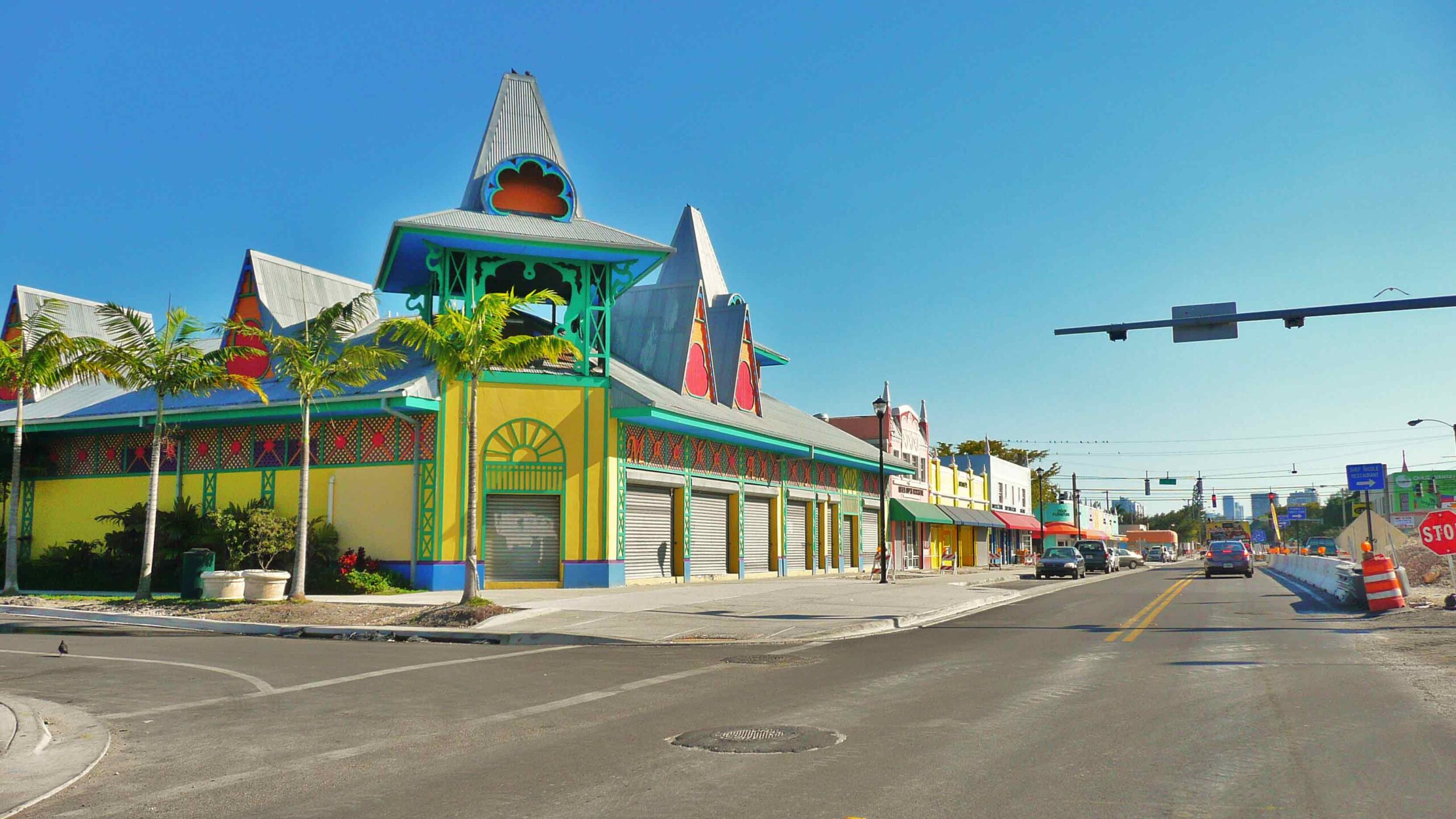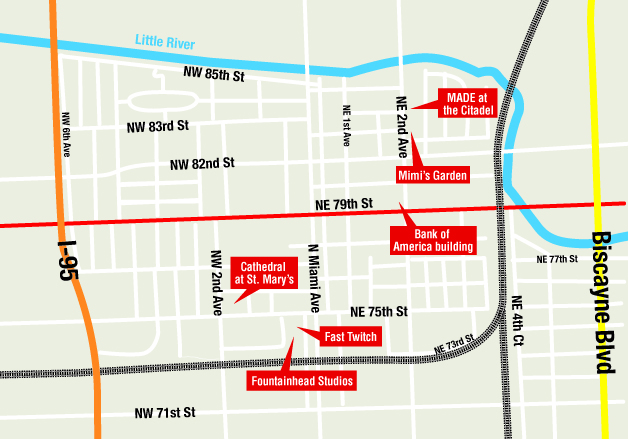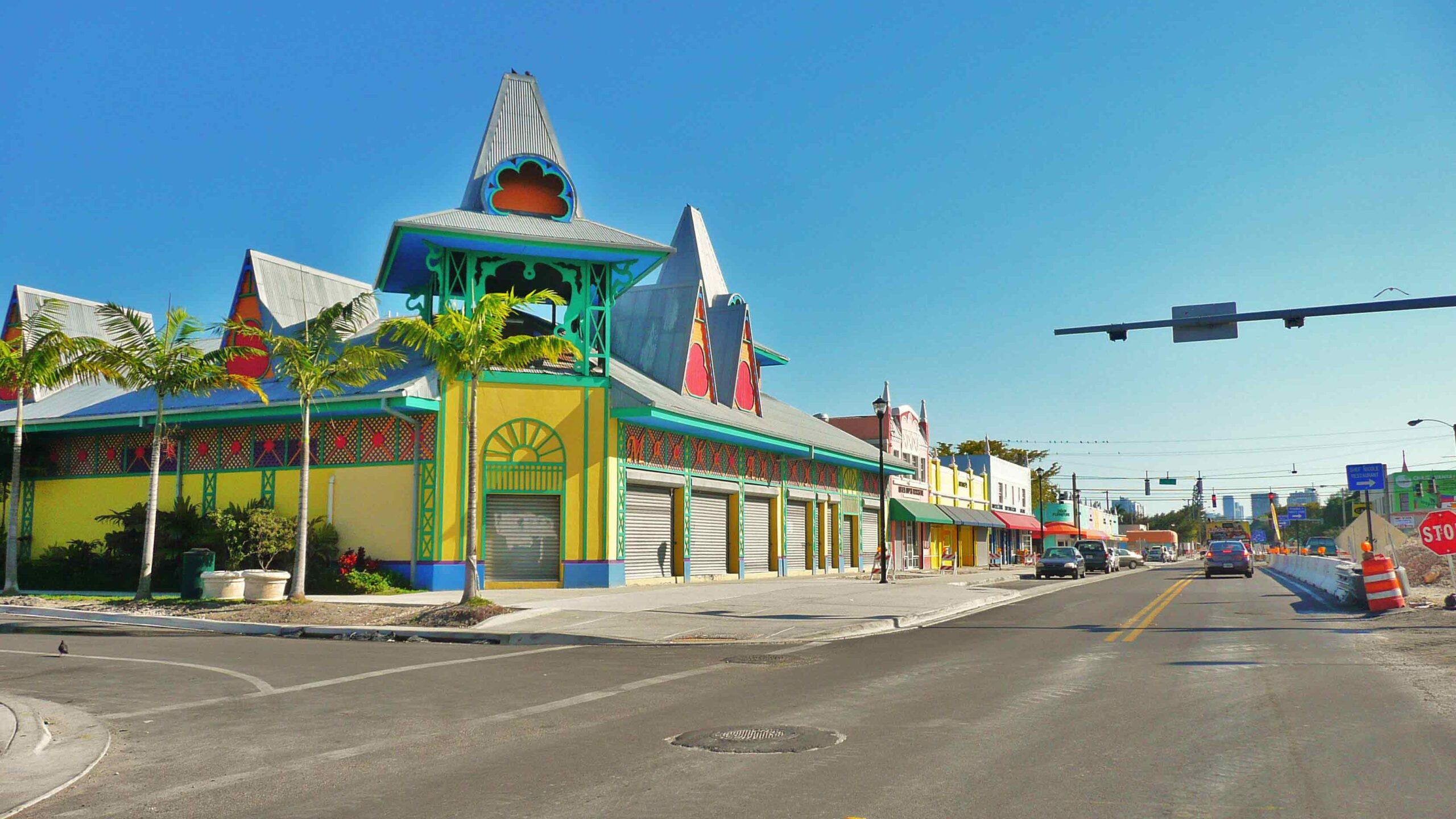Biscayne Times Article
Written By Erik Bojnansky, Senior Writer; Photos By Silvia Ros
MAY 2015

A mile west of Biscayne Boulevard and the MiMo District, Little River // Miami’s neighbors include rag shops, car mechanics, and a couple of metal recycling ventures. There are also a few cafeterias nearby and churches — the largest being the ornate Cathedral at St. Mary’s, which has existed at 7525 NW 2nd Ave., in one form another, since 1936.
For the past few years, this area has been attracting artists and specialty businesses in growing numbers.
In all Jain, Vander Werff, and their financial backers own or are contracted to buy more than eight acres of land — some contiguous, some not — roughly between NW 71st Street and NW 75th Street, and N. Miami Avenue and NW 2nd Avenue. That’s roughly 20 city blocks.
“We wanted to find a neighborhood where we could own enough land to achieve critical mass, so we quickly and quietly assembled quite a few properties,” says Vander Werff, formerly an executive with the Fifteen Group, a land acquisition firm. “We started out with seven [properties] at the very beginning, and we’re now up in the 50 range. And we’re still going.”
Jain and Vander Werff even have a name for their piece of Miami: Little River // Miami. The twin slashes symbolize the Florida East Coast railroad that transects their future neighborhood. “They’re a part of the history of Miami,” Jain declares. “It’s what connected Miami to the rest of the country.”
But this is just the beginning. Jain and Vander Werff say they intend to pack Little River // Miami with galleries, tech startups, restaurants, bars, art studios, and other unique businesses. Among their confirmed new tenants are Vanity Projects (a video gallery and designer nail salon from New York), Hot Satellite (a pizza establishment from Los Angeles), Bill Brady Gallery (a contemporary gallery founded in New York), FJ Company (a car restoration business specializing in Toyota J40 Land Cruisers), and a mysterious cocktail bar that’ll apparently announce itself at a time of its owners’ choosing.

Local artist Carlos Betancourt will be building his own 2000-square-foot studio, designed by his partner, architect Alberto Latorre, on a plot of land they purchased from Jain and Vander Werff last November for $60,000. Jain also hopes to bring Car2Go to the area, plant more trees, and push for a linear park along the railroad. Someday soon, Jain says, she hopes to add new apartments and condos to the mix. “This is about the arts, creatives, entrepreneurs, startups, food and beverage, interesting spaces,” Jain says. “We love the adaptive reuse possibilities. That’s part of what makes it interesting. It creates a sort of interesting organic vibe.”
Besides the dozens of warehouses, Jain likes the area’s wide streets and its proximity to I-95. And while it’s somewhat removed from Miami’s hot neighborhoods, Little River // Miami isn’t exactly in the middle of nowhere.
“We’re due west of the same thing that’s going on along Biscayne Boulevard,” she says. That “thing” is the revitalization of the MiMo District, which she helped inspire.
Avra Jain and Matthew Vander Werff: The railroad tracks have become an integral part of their project.
ut Little River // Miami is also part of a larger, gritty swath of Miami that’s north of 51st Street, east of I-95, west of the FEC railroad tracks, and south of the Village of El Portal. Within this sector of Miami are the historic neighborhoods of Lemon City and Little River. Since the 1980s, they’ve also been known by another name: Little Haiti. For decades, this once-forgotten part of Miami served as a kind of Ellis Island for Haitian immigrants. It was also a hub of commerce where numerous Haitian-owned businesses, churches, and other nonprofits opened up.
Now the warehouses, strip malls, and other commercially zoned properties are being snatched up by investors like Jain and Vander Werff, people in search of new frontiers in Miami’s overheated real estate market.
Peter Zalewski, a real estate analyst and founder of CondoVultures.com, says long-term investors are looking approvingly at Little Havana and Little Haiti, thanks to the overflow of development occurring in nearby boom areas. In Little Haiti’s case, he explains, developers are moving north from the anticipated success of the Design District, Midtown Miami, and Wynwood.
Within the overlapping Lemon City and Little River regions, significant real estate transactions have been taking place at a fast pace. For example, Todd Oretsky and Philippe Houdard, founders of Brickell-based Pipeline Workspaces, plan to build a five-story, 80,000-square-foot building that will serve as their company’s fourth and largest “co-working” office space for private contractors, artists, and other businesses.
Rick Dacey, Eddie Diaz, and Brian Best will be opening their (permanent) pizzeria Hot Satellite in the courtyard.
Besides shared meeting room space, refreshments, and state-of-the-art Internet for its tenants, publicized plans for the proposed project envision communal storage space and retail on the bottom floor. The building is slated to go up on a 13,905-square-foot parcel at 6900 NE 2nd Ave. that Oretsky bought for $400,000 this past December.
There’s plenty of buying activity farther south in Little Haiti, too. Among the new major players is California venture capitalist Bob Zangrillo. Since 2013, Zangrillo’s companies have invested $26 million, obtaining at least ten acres of land and several warehouses east of NE 2nd Avenue, according to records examined by the BT from the Miami-Dade Property Appraiser website. Zangrillo’s biggest buy was the $15 million purchase of 6.5 acres of land at 6001 NE 2nd Ave., which includes Magic City Trailer Park and the deteriorating 113-year-old Dupuis Medical Office and Drugstore building.
Tony Cho, president of Metro 1 Properties and Zangrillo’s partner, says they plan to upgrade and lease out the warehouses they now control. As for the former trailer park, “our goal is to re-landscape it, improve it, and make it an amenity for the neighborhood where cultural special events can be held,” Cho says. “That’s for the short-term. We don’t know anything beyond that. We don’t have concrete plans for the assembled lands.”
Up north in Little River, between 83rd and 84th streets on NE 2nd Avenue, Urban Atlantic Group bought four properties in April 2014 for $5.2 million. In a joint venture with Conway Commercial Real Estate, UAG invested another $1 million transforming the old J.J. Dessalines C. Center at 8325 NE 2nd Ave. into its own co-working venture called MADE at the Citadel — the MADE standing for Makers Artists Designers Entrepreneurs.
Across the street from MADE stands an empty, 64-year-old, 65,000-square-foot building that Conway says he intends to renovate and reopen as a traditional office building with retail on the ground floor.
While Vander Werff is focused on developing creating Little River // Miami as a cohesive community, Jain has been buying properties with other investors elsewhere in Little River. One such investment is hard to miss. On March 31, through a California holding company, Jain bought the former seven-story Bank of America building at the corner of NE 2nd Avenue and 79th Street (7924 NE 2nd Ave.) for $6.2 million from Pedro Rodriguez, owner of the Presidente Supermarket chain, who previously tried to transform the 178,810-square-foot building into an affordable-housing project.
Jan Mapou: “They’re buying almost everything they can put their hands on in Little Haiti. They’re offering a lot of money for the old buildings.”
“The prices are going up in Wynwood. A lot of people are moving out,” says Moody, who co-produced the “Little Haiti Country Club” exhibit last August at a nearby retail building co-owned by Jain at 8267 NE 2nd Ave. “Now we’re working to carefully gentrify this neighborhood, to keep people here rather than doing the same thing.”
In Wynwood’s case, artists and galleries played a huge role in reviving an area once wracked with crime and poverty following the departure of much of its manufacturing base in the late 1980s and early 1990s.Twelve years ago, only galleries were interested in renting in Wynwood, says David Lombardi, principal of Lombardi Properties, which owns several Wynwood buildings. Today the neighborhood is visited by an estimated 150,000 people each month and is flooded with restaurants, stores, bars, and offices, while various developers are hatching plans for new retail and residential projects.
“Wynwood,” Lombardi says, “is going through an incredible transition.”
That transition has jacked up rents. In 2011, rents in Wynwood ranged between $15 and $20 a square foot, Lombardi notes. Now they’re anywhere from $20 to $60 a square foot.
Lombardi, who insists he’s still enthusiastic about Wynwood’s future, also owns property in Little River, just north of MADE at the Citadel. There he’s asking for rents at about $12 a square foot. “It’s in its infancy,” Lombardi says of this northern neighborhood. “It’s like the early Wynwood days. It’s got a good energy up there.”
A small number of artists have been operating in warehouses in Little Haiti and Little River for more than a decade, but their numbers are growing fast. Yuval Ofir represents local artists and runs the Yo Miami arts studio out of a converted warehouse his family has owned for decades at 294 NE 62nd St. His family also owns a perfume distribution business in Wynwood’s fashion district.
According to Ofir, many galleries and artists once based in Wynwood are migrating northward because their landlords increased their rents. “Artists were forced out [of Wynwood] a long time ago,” he says. “The biggest migration happened two or three years ago.”
But how much longer can artists or small-business owners afford to rent in Miami’s northern reaches? Ofir of Yo Miami notes that developers are renovating warehouses all over the area, and they’re already asking for higher rents, an observation confirmed by Tony Ulloa, a broker with Keyes Commercial Realty. “Prices have gone up significantly over the past year,” he says. “There’s a demand for space from artists being misplaced from Wynwood and the Design District.”
But the current demand isn’t just from artists, Ulloa adds. Thanks to the PortMiami expansion, which is projected to increase freight traffic, buyers are scrambling to acquire warehouse space near the railroad tracks, which run east-west near 73rd Street.
The Little River area, Ulloa explains, has “the highest concentration of warehouses serving the rail system, north of Wynwood.”
Aside from several subsidized housing projects in Little Haiti, much of the housing available in the area — while far from being in pristine shape — is inexpensive compared to most places east of I-95. This could change in a few years.
Real estate analyst Peter Zalewski predicts that when the next development cycle commences, buyers will look at Little Haiti’s residential areas. “The appeal is cheap nearby real estate relative to what properties are trading for in the more established markets,” Zalewski says. “At this point, Little Havana has the advantage because of the looming up-zoning process. That being said, Little Haiti enjoys the advantage of catching the attention of the big-money developers who are attracted by the area’s lack of modern housing.”

